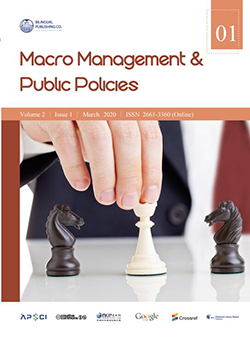-
923
-
357
-
276
-
266
-
251
Determining Benchmarks for Cargo Throughput Performances of Privatized Seaports in Nigeria
DOI:
https://doi.org/10.30564/mmpp.v2i1.963Abstract
There exists the challenge of seeming lack of empirically determined cargo throughput benchmark models for the privatized West African port terminals particularly in Nigeria, as target benchmarks which terminal operators and port authorities must drive towards to ensure that the current improvement in port productivity experienced in the post concession era is sustained. The study was therefore aimed at developing benchmarks for the cargo throughput performances of the privatized five Nigeria ports of Apapa (Lagos), Port-Harcourt, Onne, Warri and Calabar. Such benchmarks developed for each seaport must be higher than the pre-privatization cargo throughput performances of the seaport. This became important following the improvements observed in the cargo throughput performances of the various ports from the year 2006 after the privatization of the ports and the recent recession faced in the Country which seems to have retarded the cargo throughput performances and other measures of seaport performance in the various Nigeria ports. Using Cp1, CL1, Cw1, Co1, Cc1, to represent the base year 2006 cargo throughput performances of Port-Harcourt, Lagos, Warri, Onne and Calabar seaport respectively; and n, d, to represent the number of post privatization years covered in the study and common difference in cargo throughput performances; the study used a historical design approach in which time series data on cargo throughput performances of the ports were obtained from the Nigeria ports Authority (NPA) annual statistical reports were analyzed using the converging and diverging arithmetic series mathematical modeling tool and MATLAB software, to determine benchmark models, for ensuring that the improved cargo throughput performances of the various seaports, are sustained to remain higher that the pre-privatization cargo throughput performances. The study developed the following Cargo throughput benchmark models for each seaport as findings. Lagos port = CL1 + (n – 1)d ≥ 15223340; Onne port = Co1 + (n -1)d ≥ 15820381; Port-Harcourt port = Cp1 + ( n -1)d ≥ 28016979; Warri = Cw1 + ( n-1)d ≥4643128; Calabar = Cc1 + (n-1)d ≥ 7963434. It was recommended that to improve port revenue which is a dependent factor on cargo throughput and vessel call rate, cargo throughput benchmarks model developed for the individual seaports should be used to empirically model quantum s of cargo throughput needed to economically sustain and improve the level of port operations. It should equally influence port marketing drives. This will ensure that the performance of the ports does not recede into the poor performance indices experienced in the pre-privatization era.
Keywords:
Benchmarks; Cargo throughput; Privatized-seaportsReferences
[1] Boxwell Jr, Robert J. Benchmarking for Competitive Advantage. New York: McGraw-Hill. 1994: 225. ISBN 0-07-006899-2.
[2] Buhari, S.O., Ndikom, O.B., Nwokedi, T.C. An assessment of the relationship among cargo-throughput, vessel turnaround time and port-revenue in Nigeria. (A study of Lagos port complex). Journal of Advance Research in Business, Management and Accounting. 2017, 3(7).
[3] Bassey, J. B. & David D. E. The impact of Concessioning on Performance of Calabar Seaport. Multidisplinary Jouraial of Research on Developmental Perspectives. 2014, 3(1), 56-62.
[4] Invernizzi, D. C.; Locatelli, G.; Brookes, N. J. How benchmarking can support the selection, planning and delivery of nuclear decommissioning projects. Progress in Nuclear Energy. 2017, (99):155–164. DOI: https://doi.org/10.1016/j.pnucene.2017.05.002
[5] Moriarty B. A theory of Benchmarking. University of Wisconsin PhD Thesis, 2008.
[6] Ndikom O.B.. Kernel concept of shipping operations, policies and strategies: the industry overview. Bunmico publishers, Lagos, 2006.
[7] Nwokedi, T.C., Emenike, G.C. Sustainability Planning and Benchmarking of Post Concession Performance of Nigerian Seaports: The Case of Onne Seaport. Journal of ETA Maritime Science, 2018; 6(3): 181-197. DOI: https://doi.org/10.5505/jems.2018.95914
[8] Nwokedi T.C., Emeghara G.C., Ikeogu C. Trend Analysis of Impacts Of Cargo Pilferage Risk On Post Concession Cargo Throughput Performance Of Nigerian Seaport Terminals. International Journal of Research Commercial and Management. 2015, 5 (7): 11-15. DOI: https://doi.org/10.11648/j.ijtet.20180401.12
[9] Okeudo G.N. Effect of Port Reform on Cargo Throughput Level at Onne Seaport Nigeria. A Comparative Study Before and After Reform Policy Implementation. IOSR Journal of Business and Management, 2013, 12(1), 71-78.
[10] Olaogbebikan J. E., Njoku, I. Faniran A. O. and Okoko E. Performance Evaluation of Nigerian Ports: Pre and Post Concession Eras. Civil and Environmental Research, 2014, 6(2).
[11] Webster, M. Webster online English dictionary, 2018.
[12] NPA. Nigeria Ports Authority (NPA) brand manual. 2015 edition.
Downloads
How to Cite
Issue
Article Type
License
Copyright © 2019 Author(s)

This is an open access article under the Creative Commons Attribution-NonCommercial 4.0 International (CC BY-NC 4.0) License.




 Theophilus Chinonyerem Nwokedi
Theophilus Chinonyerem Nwokedi

